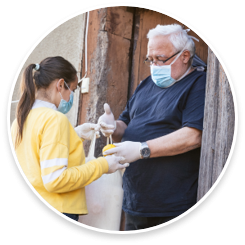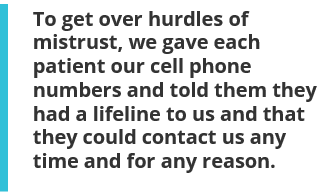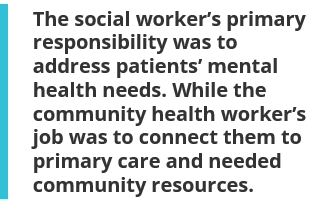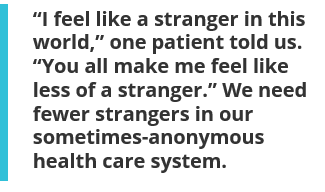By Yolanda Sutton, CHW, and Brisa Samudio, LCSW, CareMore Health System and Aspire Health
Many health care organizations have been experimenting with programs to better serve Medicaid beneficiaries with complex health and social needs. In 2015, CareMore Health developed a program in Memphis, Tennessee to provide comprehensive care to this group of patients. Early analysis revealed that the top five percent of CareMore’s highest-cost Medicaid members in Memphis incurred roughly 70 percent of all spending. Most of the people in this group had multiple chronic medical conditions, often with co-occurring behavioral health conditions and significant social needs, ranging from housing instability to food insecurity.
CareMore’s complex care management program in Memphis resulted in a nearly 40 percent reduction in total medical spending per patient per year and an almost 60 percent reduction in inpatient utilization. This was driven primarily by decreases in hospital utilization, accompanied by a small decline in specialist visits.
This program was successful because of the interventions of primary care physicians who took the time to understand their patients and provide them with wraparound primary care, which resulted in fewer trips to the emergency department (ED). But the program was also successful because, by design, CareMore augmented its primary care physician-led medical home model with full-time community health workers and social workers like us. In the interest of helping other health care organizations lower costs and improve outcomes for high-need patients, we’re sharing our story.
It Starts with Relationships
When we began our work, we identified 253 patients who had high utilization rates and high costs, but who were not getting optimum results (patients were randomized in a 1:2 ratio to complex care management or usual care). One patient, for example, had $252,000 in billings in a 12-month time period — largely due to ED visits. After looking at the data, we knew we’d have to focus on relationships with this patient population to build trust and to get them to understand the importance of primary care.
When we first contacted the patients, we told them who we were, why this call was important, and that we cared. “This is a different type of health care we’re about to give you,” we told them. “We want you to experience what you’ve never experienced before in health care — a no-judgment zone.” Most of the patients had never had anyone from a health care system reach out personally, or with that kind of message. Some were shocked to hear from us and even a little distrustful. But we let them know from the outset that our goal was to keep them out of the ED and that their primary care doctor could help them with that goal. To get over hurdles of mistrust, we gave each patient our cell phone numbers and told them they had a lifeline to us and that they could contact us any time and for any reason.
Designing Care Plans
After our initial phone contacts, patients who enrolled in the program were scheduled for a 60-minute in-person visit with the entire care team (community health worker, social worker, and primary care provider). We then spent at least 30-45 minutes with the patients on subsequent visits, allowing us to conduct a comprehensive assessment of their medical, behavioral, and social risk factors.
Most of the patients in the program had spent years being given orders by various anonymous clinicians. We wanted to ensure that patients were engaged in the program, were the drivers of their own health care decisions, and were involved in developing their care plans. With patient permission, we included family in the interventions we introduced. Some of the family members were not even aware of the severity of their loved ones’ complex illnesses. We educated the family on the importance of keeping appointments, taking medications, and following care plans so they could influence their loved ones and help them reach their health goals.
Roles and Silos
In the field, the social worker’s primary responsibility was to address our patients’ mental health needs. The vast majority of our patients had experienced significant trauma at some point in their lives. Meanwhile, the community health worker’s job was to connect them to primary care and needed community resources. If patients had unstable housing, the community health worker helped them find a stable place to live. If they couldn’t pay bills, the community health worker connected them with services to keep the lights on.
Internally, we always strived to keep open lines of communication among ourselves and to make sure we weren’t providing siloed care. That meant working collaboratively with the clinical team to close gaps in care for each individual. After discussions with the physicians, we made sure patients kept appointments with specialists and had regular mammograms, eye appointments, and other preventive screenings.
Beyond Health Care
Years of collective experience have taught us that unmet social needs can become barriers to successful health outcomes. We know that it is difficult to address medical issues if people lack housing, sufficient food, or support systems. Targeting our patients’ basic needs was crucial in building a path to results for the complex care management program. We knew that patients would be able to focus on their health if they weren’t wondering where their next meal might come from.
Addressing patients’ social needs was frequently challenging. We often visited patients in their homes to better understand their living situations and assess their needs. We ultimately made inroads by nurturing relationships with an array of community services providers, such as substance use specialists, affordable housing managers, and food banks. For example, after securing new housing for several patients, we made sure they received transportation to their new homes and followed up with the housing manager to address any concerns.
Through all of these means, we were able to do the one thing that made the biggest difference to our patients: follow through to ensure patient needs are met. Follow-through is crucial to building trust with patients. When you build trust, patients are more likely to work with you to address their health needs. We think that level of follow-through and trust-building is the reason that nearly every patient told us we were different from everyone else they’d encountered in the health system.
“I feel like a stranger in this world,” one patient told us. “You all make me feel like less of a stranger.” We need fewer strangers in our sometimes-anonymous health care system. We believe the way to achieve that goal is to have clinicians work in partnership with social workers and community health workers to lower costs and make significant impacts on the lives of people with the most complex health and social needs.




